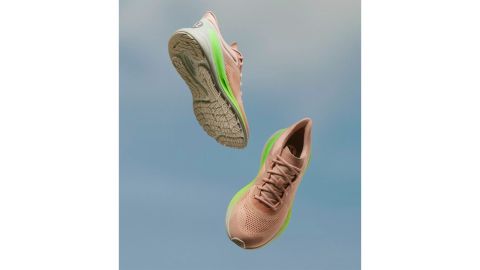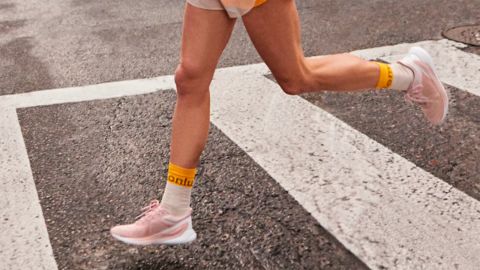
We put Lululemon’s first running shoe to the test — here’s how it held up
My earliest memories of athleisure include browsing through the rows of leggings at Lululemon in the early 2000s, with a goal to own — or at least test out — each pair. Like so many devout Lululemon enthusiasts, I began stalking their website every day for new releases: That’s why Lululemon’s landmark women’s running shoe release is such a huge deal. The Blissfeel is a welcome addition to the brand’s growing inventory of apparel, accessories and fitness gear.
They’ll be on shelves in select locations across North America, Mainland China and the UK as of March 22, and we got to put them to the test so you can determine whether they’re right for you.
Whether you’re training for a race, introducing more walking or jogging into your routine, or need a solid running shoe to take you from one end of a massive airport terminal to the other, the Blissfeels have your back (and feet). The Blissfeels came to be when the brand analyzed the foot scans of over one million women in order to create a shoe designed specifically for the female foot, which tends to differ from men’s feet at the arch, the lateral side of the foot, the first toe and the ball of the foot, according to research from the journal Medicine and Science in Sports and Medicine. The ventilated upper is designed to give you that naked next-to-nothing sensation, and the foam cushioning softens impact on your joints during high-intensity movements. They come in full and half sizes 5 to 11 and retail for $148 a pop.
I wouldn’t normally gravitate towards a running shoe with a traditional silhouette like these, but honestly, Lululemon could literally slap its logo on a garbage bag, and I’d proudly rock it (guilty as charged). The shoe comes in 10 colorways, and I was pleased the brand sent me the Electric Lemon model with a black mesh upper, bright yellow detail along the side and a chunky white heel that provides some much-needed elevation on my measly 5-foot-3 frame.
Right away, I could feel its tuned foam cushioning that provides ample bounce to propel me forward. It’s a lighter shoe than I’m used to, and after this kind of pep in my step, I don’t see myself going back to anything else.

Not to harp on the details, but as someone who’s unironically considered getting a Lululemon tattoo, I appreciated the several logos. The back features an enlarged logo reminiscent of the old school variety they used to imprint on their flared Groove Pants circa 2003, and it serves as a sort of stop sign that says “Talk to me about yoga mats and heart rate monitors!” I absolutely love the more subtle logo on the side of the tongue, but was pretty disappointed to find it tucks back into the shoe when I lace them up (the website showcases said logo exposed, so this could be an issue of my own foot shape). When I first wiggled my way into them, I noticed they were a bit tight at the toe box despite being my usual size 6. Without a loop to grab at the heel, I nearly crushed my fingers trying to put them on. Even so, they cradled my foot beautifully and I felt supported from nearly every angle.
I wore them around the house for several hours, completed a mix of chores like vacuuming and folding laundry, and sat for multiple hours while I worked to see how they’d fair as an everyday shoe. Much to my surprise, the shoe took on the trajectory of a favorite vintage sweater or blanket that softens and relaxes with wear. Only this time, it took about several hours to feel like they were made for me instead of several years. They’re a bit technical if you’re going to use them strictly for everyday wear, but if you’re working out anyways, leaving them on for a bit will serve as a treat for your feet.
I was pretty nervous to deviate from my Hoka One One’s that provide unparalleled cushioning, so the Blissfeels quite literally had big shoes to fill. The moment I stepped onto the treadmill, I felt a lightness and length to my posture I hadn’t felt since I first put on my Hokas two years ago (this might be a sign it’s time to permanently replace them). I attribute this feeling to both the lightness of the shoe as well as the inch-high heel.
To give them a fair shot, I submitted the shoes to 45 minutes of sprint intervals (or “sprintervals,” as I’ve affectionately dubbed them), which combined walking, jogging, running and sprinting at maximum effort. I felt myself springing — nay, leaping! — forward in that deliciously exciting way only a new pair of running shoes can achieve. My feet and ankles felt fully supported thanks to the snug feel of the shoe, and the arch support was pronounced enough to maintain the natural structure of my foot without making me feel like I was walking on a stress ball.
I expect this to resolve itself as the shoe molds to my foot even more over time, but I did feel the tongue dig into my instep on my left foot. Like the majority of the population, my two feet vary slightly in shape and size, so this isn’t at all a dig at the shoe.
Do I consider these more of a running shoe? Yes. Would I wear them to cross-train? Only if I’d been running beforehand, and looking to add bouts of resistance training to an existing cardiorespiratory routine. The shoes really shine in the cushion department, and certain schools of thought preach that you should steer clear of any types of bouncy materials with too much give while weight-training or cross-training. Otherwise, the shoe might inadvertently assist you throughout your movement, while encouraging you to rely on momentum instead of your intrinsic strength. These shoes were a joy to wear in the comfort department while I performed jump squats, deadlifts and back lunges combined with lateral raises.
Here’s where it gets a bit interesting: The traction is almost too good. My gym is carpeted, so I felt the grooves and ridges get stuck in its fibers during movements that incorporate sliding or side-stepping, like side lunges. This leads me to believe they’d fare well on glossy hardwood or even ice (I wouldn’t recommend them as a winter shoe per se since they’re pretty thin and highly ventilated). As I’ve only owned them for a week now, I can’t speak to how well the traction will hold up after months or years of use.

If you’re looking for a new running shoe to add to your repertoire, the Blissfeels make for a solid bet. At $148 for a pair, they’re no doubt pricey, but fall within the average sneaker price range.
Later this year, the brand will release three more shoes: the Chargefeel, Restfeel and Strongfeel, with a men’s collection slated for release in 2023. Because the Blissfeels won me over, I’m that much more excited about their upcoming shoe releases, and will be sure to report back so that you, too, can share in this blissful sneaker joy.
Source: https://www.cnn.com/2022/03/22/cnn-underscored/lululemon-blissfeel-running-shoe-review/index.html?iid=CNNUnderscoredHPcontainer















